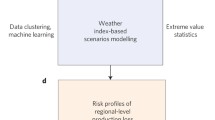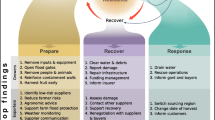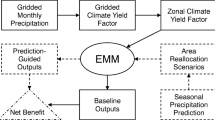Abstract
A reliable forecast of food production in a given region, under the effects of climate change and increased occurrence of extreme events, is a prerequisite to developing resilience in the future food supply. As the climate is changing, an increasing occurrence of extreme events combined with shift in seasonal weather pattern is rendering traditional agricultural practices a high level of risk. Currently, strategies to plan for an upcoming season are based on data from the recent seasons. Current methods to forecasting food production levels and derisk an upcoming season in any given region, are rudimentary and at best, not scalable. The advent of big data and new data sources such as weather forecasts, remote sensing, scalable machine-learning methods and cloud computing has created new opportunities for understanding the impact of an upcoming growing season. In order to demonstrate the usefulness of the current data sources and methods, this chapter presents a methodology that combines seasonal weather forecasts, geo-spatial information derived from remote-sensing, risks posed by extreme events and crop growth models to estimate production risk at a regional scale. The method was validated for multiple growing seasons in some counties in Iowa.
Access this chapter
Tax calculation will be finalised at checkout
Purchases are for personal use only
Similar content being viewed by others
References
Beddow JM, Pardey PG (2015) Moving matters: the effect of location on crop production. J Econ History 75:219–249. https://doi.org/10.1017/S002205071500008X
Boogaard H, Van Diepen C, Rotter R, Cabrera J, Van Laar H (1998) WOFOST 7.1; user’s guide for the WOFOST 7.1 crop growth simulation model and WOFOST Control Center 1.5. SC-DLO
FAO: FAOSTAT (2021) http://www.fao.org/faostat/en/
Guo D (2008) Regionalization with dynamically constrained agglomerative clustering and partitioning (REDCAP). Int J Geograph Inf Sci 22:801–823. https://doi.org/10.1080/13658810701674970
Ham Y, Kim J, Luo J (2019) Deep learning for multi-year ENSO forecasts. Nature 573:568–572
Hengl T, Mendes J, Heuvelink GB, Ruiperez Gonzalez M, Kilibarda M, Shangguan W et al (2017) SoilGrids250m: global gridded soil information based on machine learning. PLoS one. 12:e0169748
Hersbach H, Bell B, Berrisford P et al (2020) The ERA5 global reanalysis. Q J R Meteorol Soc 146:1999–2049
Jiang H, Hu H, Zhong R, Xu J, Xu J, Huang J, Wang S, Ying Y, Lin T (2020) A deep learning approach to conflating heterogeneous geospatial data for corn yield estimation: a case study of the US Corn Belt at the county level. Global Change Biol 26:1754–1766. https://doi.org/10.1111/gcb.14885
Jones JW, Hoogenboom G, Porter CH, Boote KJ, Batchelor WD, Hunt L, Wilkens PW, Singh U, Gijsman AJ, Ritchie JT (2003) The DSSAT cropping system model. Eur J Agron 18:235–265
Ju S, Lim H, Heo J (2020) Machine learning approaches for crop yield prediction with MODIS and weather data. Presented at the January (2020)
Lobell DB, Gourdji SM (2012) The influence of climate change on global crop productivity. Plant Physiol 160:1686. https://doi.org/10.1104/pp.112.208298
Lu S, Shao J, Freitag M, Klein LJ et al (2016) IBM PAIRS curated big data service for accelerated geospatial data analytics and discovery. In: IEEE big data. IEEE, pp 2672–2675
Monfreda C, Ramankutty N, Foley JA (2008) Farming the planet: 2. Geographic distribution of crop areas, yields, physiological types, and net primary production in the year 2000. Global Biogeochem Cycles 22. https://doi.org/10.1029/2007GB002947
Nevavuori P, Narra N, Lipping T (2019) Crop yield prediction with deep convolutional neural networks. Comput Electron Agric 163:104859. https://doi.org/10.1016/j.compag.2019.104859
Ray DK, West PC, Clark M, Gerber JS, Prishchepov AV, Chatterjee S (2019) Climate change has likely already affected global food production. PLoS one 14:1–18. https://doi.org/10.1371/journal.pone.0217148
Rousseeuw PJ (1987) Silhouettes: a graphical aid to the interpretation and validation of cluster analysis. J Comput Appl Math 20:53–65. https://doi.org/10.1016/0377-0427(87)90125-7
Schwalbert RA, Amado T, Corassa G, Pott LP, Prasad PVV, Ciampitti IA (2020) Satellite-based soybean yield forecast: integrating machine learning and weather data for improving crop yield prediction in southern Brazil. Agric Forest Meteorol 284:107886. https://doi.org/10.1016/j.agrformet.2019.107886
Smith ANH, Anderson MJ, Pawley MDM (2017) Could ecologists be more random? Straightforward alternatives to haphazard spatial sampling. Ecography 40:1251–1255. https://doi.org/10.1111/ecog.02821
Steduto P, Hsiao TC, Raes D, Fereres E (2009) AquaCrop—the FAO crop model to simulate yield response to water: I. Concepts and underlying principles. Agron J 101:426–437
Tedesco-Oliveira D, da Silva RP, Maldonado W, Zerbato C (2020) Convolutional neural networks in predicting cotton yield from images of commercial fields. Comput Electron Agric 171:105307. https://doi.org/10.1016/j.compag.2020.105307
USDA: PSD Online (2021). https://apps.fas.usda.gov/psdonline/app/index.html#/app/home
Van Klompenburg T, Kassahun A, Catal C (2020) Crop yield prediction using machine learning: a systematic literature review. Comput Electron Agric 177:105709. https://doi.org/10.1016/j.compag.2020.105709
Yang Q, Shi L, Han J, Zha Y, Zhu P (2019) Deep convolutional neural networks for rice grain yield estimation at the ripening stage using UAV-based remotely sensed images. Field Crops Res 235:142–153. https://doi.org/10.1016/j.fcr.2019.02.022
Author information
Authors and Affiliations
Corresponding author
Editor information
Editors and Affiliations
Rights and permissions
Copyright information
© 2022 The Author(s), under exclusive license to Springer Nature Singapore Pte Ltd.
About this chapter
Cite this chapter
Twarakavi, N.K.C. et al. (2022). Big Data Analytics for Climate-Resilient Food Supply Chains: Opportunities and Way Forward. In: Reddy, G.P.O., Raval, M.S., Adinarayana, J., Chaudhary, S. (eds) Data Science in Agriculture and Natural Resource Management. Studies in Big Data, vol 96. Springer, Singapore. https://doi.org/10.1007/978-981-16-5847-1_9
Download citation
DOI: https://doi.org/10.1007/978-981-16-5847-1_9
Published:
Publisher Name: Springer, Singapore
Print ISBN: 978-981-16-5846-4
Online ISBN: 978-981-16-5847-1
eBook Packages: Intelligent Technologies and RoboticsIntelligent Technologies and Robotics (R0)




